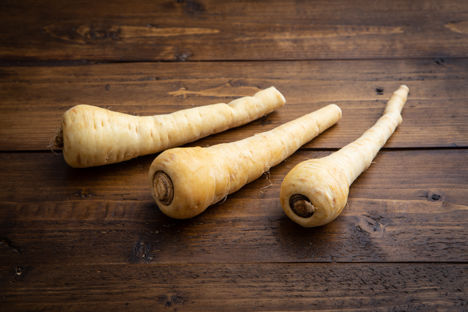Parsnips - in season from September to March - are cream-coloured, pointy vegetables with long taproots and a sweet flavour that becomes more so after winter frosts. Parsnips contain so much sugar, in fact, that the vegetable was often used as a sweetener prior to the introduction of sugar cane to Europe in the 11th Century.
While parsnips are usually consumed cooked - and most often associated with Christmas dinner - they can also be eaten raw. The flavour of parsnips is earthy and nutty, with a faint bitter note, which balances the overall sweetness. Once cooked and, often, glazed, the texture of parsnips becomes jammy, and their flavour more toasted and caramelised.
What to look for when buying parsnips
When buying parsnips, look for cream-coloured skin that’s free from blemishes and dark spots. The vegetable should be hard to the touch, with softness an indication that it was harvested a long time ago. Parsnips should be stored in a cool, dark and dry place to preserve their freshness.
Although parsnips can be frozen raw once peeled and prepped, their texture and quality will be slightly diminished and they should be kept no longer than two or three months. It’s fine to freeze cooked parsnips for six months or slightly longer.
How to prepare parsnips
Parsnips are mostly sold when they’re mature and large. If you do find some young parsnips, it’s unlikely they will even need peeling, and they can be roasted whole. However, most parsnips will need trimming at the top and bottom before peeling. The parsnips should then be chopped into large chunks, and any fibrous core removed.
How to roast parsnips
One of the most popular and simple ways to cook parsnips is to roast them, often using a glaze to enhance their natural sweetness and encourage them to caramelise. Follow our simple method for roasting parsnips below, and experiment with your own glazes and garnishes.
Metric
Imperial
- 500g of parsnip, peeled and trimmed
- 1 tbsp of honey
- 1 tbsp of vegetable oil
- 25g of butter
- flaky sea salt to season
Cut the parsnips into evenly sized wedges, removing any fibrous core
- 500g of parsnip, peeled and trimmed
Place the parsnips in a large pan of salted water, bring to the boil and cook for 5 minutes, then drain
Allow the parsnips to steam dry in a colander for 5 minutes or so
Preheat the oven to 190ºC
Toss the parsnips with the vegetable oil and honey mixture and season with salt
- 1 tbsp of vegetable oil
- flaky sea salt to season
Dot the parsnips with the butter, then transfer to the oven to roast for 40 minutes, turning halfway
- 25g of butter
How to make parsnip soup
Parsnip soup is a classic for a reason: the vegetable becomes particularly silky smooth when blended, making a comforting, velvety soup. The sweet flavour of the soup can be balanced using acidic ingredients such as citrus juice and yoghurt or sour cream, and it’s a good idea to add some texture, such as toasted seeds or croutons.
How to make parsnip purée
Parsnip makes a very classic purée that’s often found on restaurant menus in the colder months. Parsnip purée is simple to make: simply trim, peel and chop your parsnips, dicing them fairly small. Cook them in boiling salted water, then drain and blend with cream and seasoning. It does help if you have a high powered blender when making purée but if you don’t, the mixture can be passed through a fine sieve before serving to ensure a velvety smooth result.
How to bake with parsnips
How to fry parsnips
Parsnips can be deep or shallow fried to bring out another side of their character. Deep frying parsnips, for example, turns them into vegetable crisps, which can be tossed with salt and spices such as garam masala, curry powder or chilli. They can also be thinly shredded and deep fried to make a garnish similar to shoestring fries.
Shallow frying parsnips has a different result - they become crisp on the edges but remain a little softer inside. Try using them where you would usually use a potato, for example in rösti or latkes.
How do you make parsnip mash?
Parsnip mash makes a fun alternative to mashed potatoes. Trim, peel and chop your parsnips into evenly sized chunks, removing any fibrous core. Cook the parsnips in a pan of salted boiling water for 10-12 minutes, or until tender. Drain, then return to the pan and add some butter, cream, milk and your choice of flavourings before mashing (a grating of nutmeg works well). If you want the flavour of parsnips but would like to temper the sweetness, try using half parsnips and half potatoes.
What goes with parsnip?
Parsnips work very well with warming spices such as cumin and coriander, and with spice blends such as garam masala and ras el hanout. Most dairy products also complement and contrast the flavour of parsnip, so try adding tangy cheeses such as goats’ cheeses to parsnip pies and tarts, and top parsnip soup with a swirl of cream or yoghurt.
Fruits such as apples and pears also enhance the sweet flavour of parsnip; although both are also sweet, they have enough acidity and freshness to balance the earthiness of the root vegetable. Robust herbs such as sage, rosemary and thyme will all complement parsnips and work well generally with other wintry dishes, as will nuts such as chestnuts, hazelnuts and walnuts.
Get in touch
Please sign in or register to send a comment to Great British Chefs.



